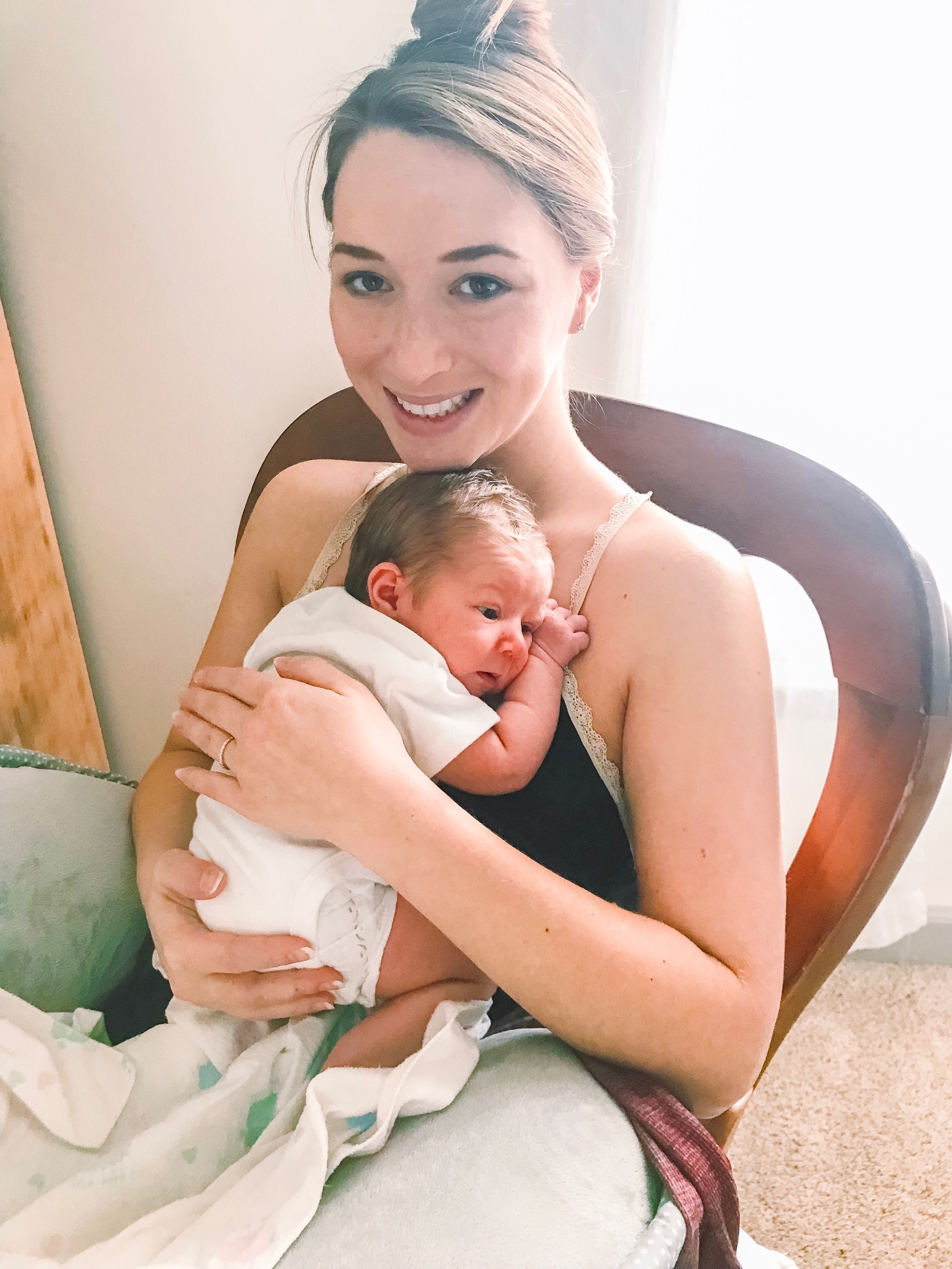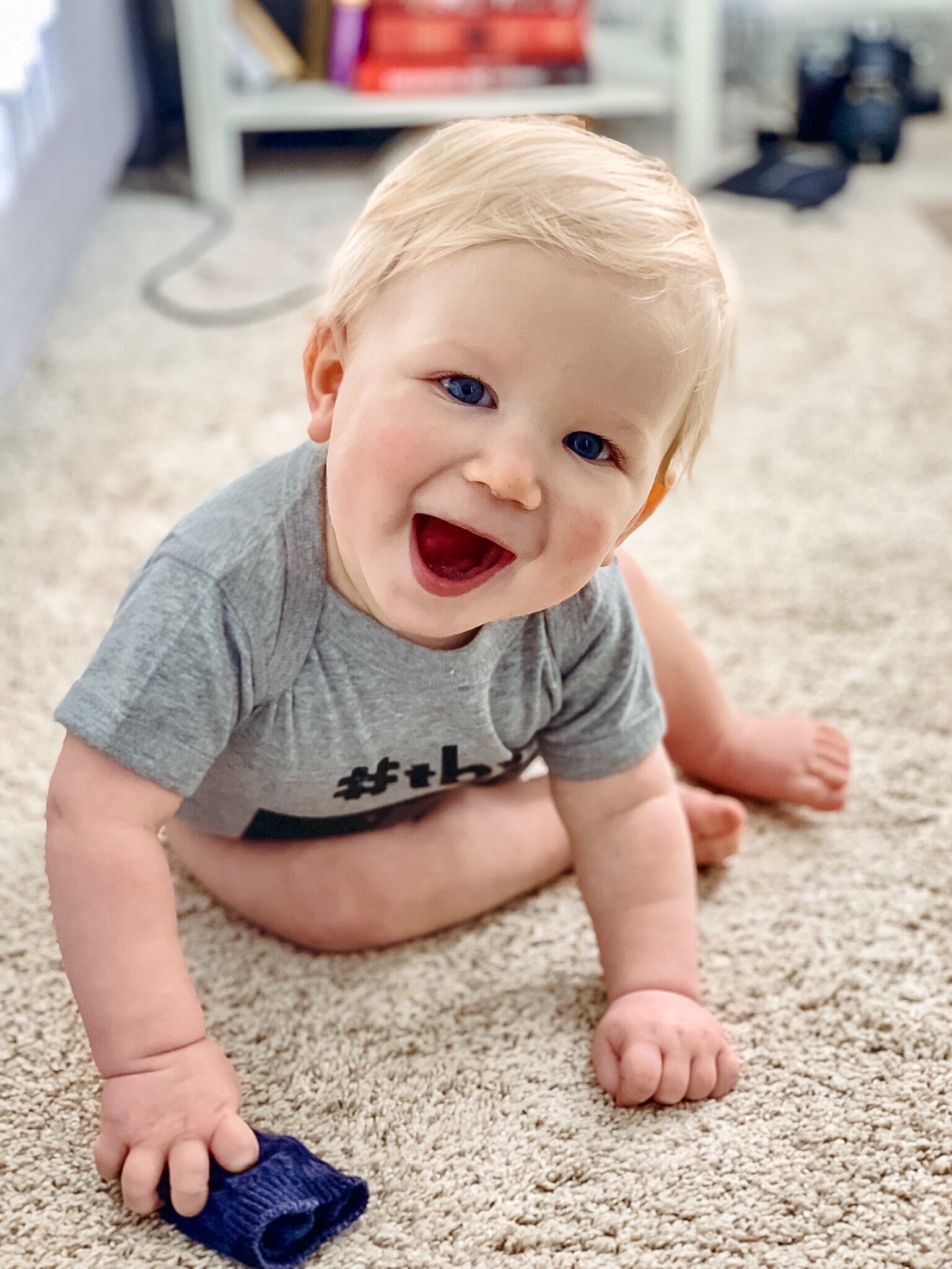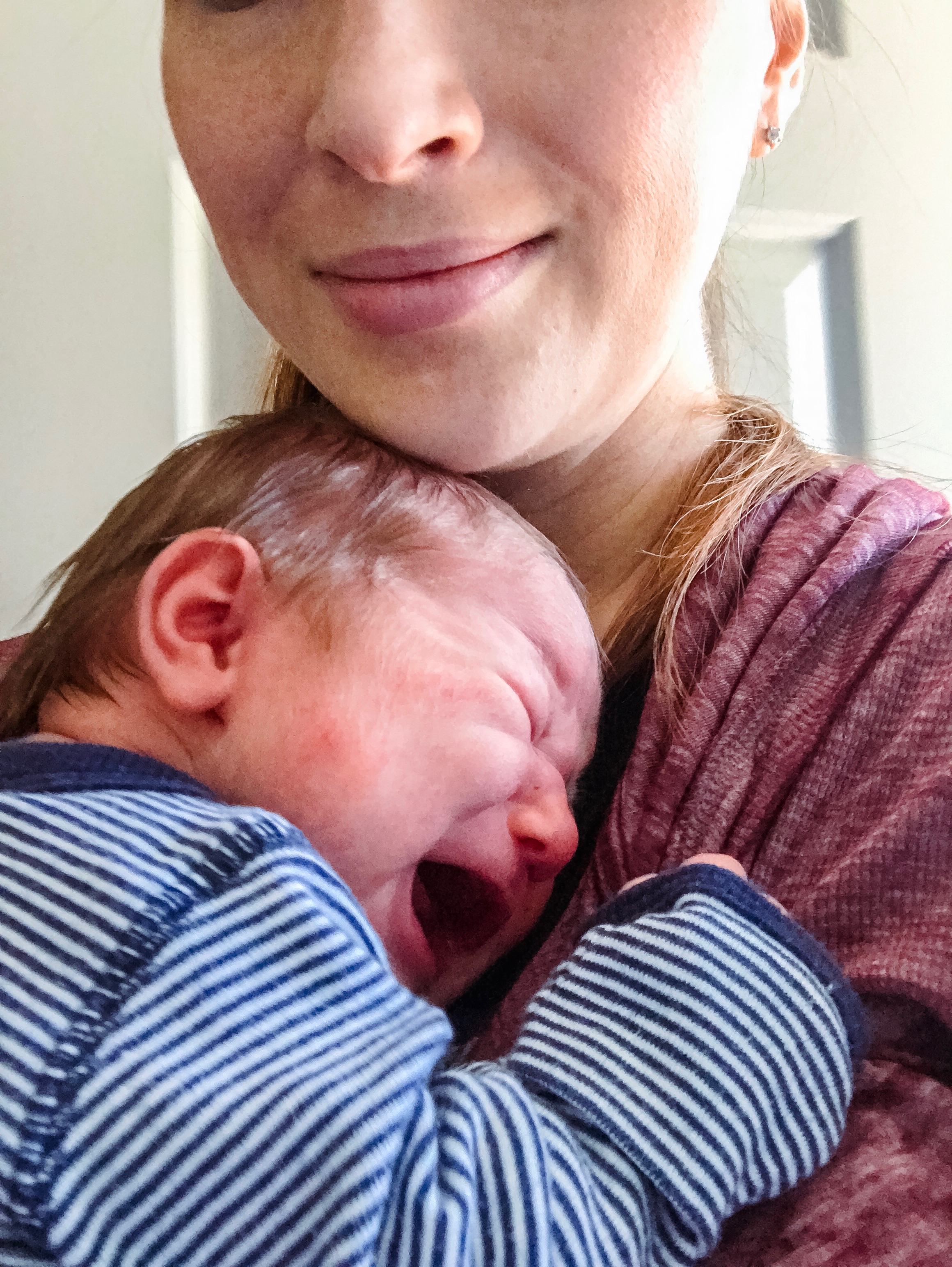our story
Week One - the bad latch
“I think he’s still hungry.” I squinted at my mother-in-law through tired eyes as she held my crying newborn. It was still dark out, and when I glanced at the clock, I slowly realized that I had only been asleep for 20 minutes. “I think he’s really hungry,” she repeated. It seemed that he was never content, and as a first-time mom I wasn’t sure if this was normal or if something was wrong.
I cradled him in my arms and walked over to our feeding chair. I stacked the usual five pillows around us to get him into the only position that worked. He used tight, pursed lips to latch, and I felt shooting pains sear from my front into my shoulder blades. I let the tears roll off my face and told my body to relax. Using my hands to express milk for him, I tried to get comfortable, but very little was coming out.
He pulled away crying frantically, and fear washed over me like waves. His weight was dropping quickly, and nothing felt “natural” about breastfeeding. My milk was slow-flowing, if at all, and I felt like I was already failing as a mom. It was like being buried to my neck in beach sand. When I tried to move my limbs against the cold, wet grains, they wouldn’t budge. My body could not do what my mind expected of it.
“Do you have any formula?” my mother-in-law asked. Formula? I hadn’t purchased any, didn’t even think about it. I was counting on breastfeeding, and no one had mentioned a ‘back-up’ to me. I was surprised she was asking anyway since I knew she had breastfed both her boys. I was about to answer no when I remembered a sample kit we’d received in the mail from a formula retailer.
“In the pantry,” I told her, and she came back with 2oz of formula a few minutes later. He downed the entire bottle, and his whole body relaxed. He fell asleep after that, and it was the most content I had ever seen him.
Week Two - lip and tongue ties
The next day, my husband ran to the store for nipple shields. The lactation nurses had advised against it, but with all the bleeding and blistering, I assumed they would approve now? Regardless, I couldn’t get my son to stay latched to feed.
On Monday, we made an appointment at the lactation clinic and I showed up eager for answers. I had to wear the nipple shields to get buddy to latch, and they weighed him before and after a feeding session. The news was good that day! He was getting half an ounce less than what he needed at each feeding. That didn’t sound so bad. They sent me home with a hospital-grade electric breast pump and a note to talk to our pediatrician about lip and tongue ties - and something about “extra” skin under his lip. I felt much better. We were going to figure this out.
Little buddy after a morning of surgery and tongue exercises - he was 3 weeks old.
We were able to see our pediatrician the following day, who then referred us to a specialist for a lip and tongue tie cutting procedure (called a frenotomy). We’d have to wait a week before they could perform the procedure, and it was the longest 7 days of my life.
Buddy cried loudly as he was strapped to an operating table and the numbing agent was injected into his gums. I stood at the back of the room so my mom instincts wouldn’t allow me to pull him off the table and run. The procedure lasted less than 10 minutes, and we were holding a sleeping boy afterwards.
When he woke, I put him to my breast without the shields. They told us that many babies nurse better immediately after surgery. But he couldn’t stay latched. His mouth looked small, his pursed lips forming a tight C-shape on my nipple. The PA encouraged me that it would improve as he healed. Since he couldn’t feed well, we rushed home to my new best friend, the breast pump. I was pumping after every feeding, in between feedings, and cluster pumping in the evenings; lathering my nipples in a special ointment, soaking them, rinsing them; hand expressing to relieve milk blebs and clogged ducts; all combined with a steady diet of galactagogues and water at every meal.
I hated the pump. The vacillating hum of the motor, the unnatural pulling on my breasts, the time spent without my baby in my arms. But I was so optimistic. I just knew it was going to pay off eventually.
Week Three - reflux baby
We tried 12 times a day for the next week, but he could never nurse without the shields. At this point, my nipples were calloused from the damage, so the pain of his latch had lessened. But he still wasn’t able to hold on for very long. The lactation specialists assured me that my nipples were “fine” for breastfeeding, but something wasn’t adding up.
When his lip and tongue were completely healed from the frenotomies, our nursing sessions weren’t improving. He pulled away crying, gagging, hiccuping, gurgling, arching his back, and spitting up. We touched base with our pediatrician, who diagnosed him with moderate to severe GER (gastroesophageal reflux). He told us that it is not uncommon in young infants and usually improves when their esophageal sphincter is fully developed. He prescribed baby Zantac and infant cereal to thicken his milk so it would stay down. I was torn about giving him medication and cereal so soon, but I knew that he was gaining weight too slowly and totally uncomfortable every time he ate.
We were nursing for 45 minutes at a time, and he was still hungry afterwards. Where was the milk?! We were supplementing with formula and finally seeing his weight recover after nearly a month earth-side. I was relieved that he was doing better, but I knew the bottle was only going to increase our breastfeeding challenges.
A few friends shared books and online resources about increasing my milk supply. We visited the lactation clinic again, and this time the news wasn’t as good. My supply wasn’t increasing at all, and he would need formula after every breastfeeding session. He was having to work too hard, so if we really wanted to breastfeed, I would have to increase my milk supply. I didn’t really care about the discomfort anymore. We were invested now. But I really did hate the pump.
Week Four - groundhog day
Daddy was back at work, and it was just me and buddy at home. During breastfeeding, we repositioned about 6 times in a span of 30 minutes. We worked at it for 30-45 minutes, then I gave him a bottle for 20 minutes, and afterwards I pumped for 30 minutes while he lay next to me studying the world. We’d been doing this for a few weeks. The whole process was about 1.5 hours, and it repeated everyday in 2-3 hour cycles. We were living the same day over and over. As he rested longer at night, I got up to pump, the darkness louder than the sound of the machine.
We tried more strategies. Laid-back feeding, pumping a little milk before feeding to start the flow, hand-expressing during feeding, and adjusting his lips throughout (an action my lactation consultant called the flipple). There was one time of day, around 5:00am, when I could magically get him to feed from the breast for about 10 minutes with little support. I think it was because I had more than 2oz to offer in the early morning. This was my brief taste of what breastfeeding could be like, and it kept me going. There was something maternal, natural, provisional about it. We were going to do this. I hadn’t planned on nourishing him any other way.
Eventually, he refused the breast at that time of day, too.
Month Two - “let it go, let it go.” no way, elsa.
Buddy’s reflux had improved with our intervention, but it was still a very big and uncomfortable part of his feeding - whether from the breast or the bottle. It was lonely during the day with just the two of us. Sometimes I wished I could grow a third arm to help coordinate holding his body while positioning his head, pushing him onto my breast, then flaring his lips out for him. Just getting him latched was a marathon, and doing it multiple times in one sitting was annoying and exhausting for both of us.
As the sun set each day, anxiety like I had never felt crept behind me like a shadow. I dreaded the night to tears. At this point, I was starting to lose hope. Something in my gut told me that I should let it go for both our sakes. But you know how determined moms are to do what they think is best for their child. Although, I wasn’t so sure it was best anymore.
We went in for buddy’s two month check up, and our pediatrician said that I should probably stop trying if it hadn’t worked by now. I cried and ached in my heart as we drove home, but by the time we got there, I had resolved to ignore that medically-minded doctor and figure out what else I had missed. The breastfeeding hotline people, my lactation specialists, and almost every mom friend I had said that the discomfort went away, babies got the hang of it, and it became effortless eventually.
But a few moms (bless their souls!) told different stories - exclusive pumping, low milk supply, weaning due to postpartum medication, health issues, premature birth, and an impossibly bad latch. One of my close friends had a son with terrible reflux and said that her milk was like “poison” to him. I wasn’t alone, and yet all these struggles still felt silent. Why were the lactation experts afraid to tell me that it may not work for us? Did it seem like I was going to give up too soon?
Month Three - The last
strawtube
I read a great book about breastfeeding problems and felt like 5 of the “conditions” might apply to us. I began exclusively pumping and finally figured out my milk supply: a maximum of 16oz per day pumping 8 times a day. If I dropped a pumping session, then I dropped 2oz - even though your supply should be established by 12 weeks. If I ate poorly, wasn’t rested, or didn’t drink enough water, then I produced about 10oz. Some of the exclusive pumping moms in an online support group told me that they got 30-50oz each day. I envied them, but I also knew some moms would love to produce even 10-16oz.
When buddy was 14 weeks old, an at-breast supplementer arrived for us. It was a SNS, or Supplemental Nursing System tube. No one had recommended this when he was younger, but I thought it was worth a shot now. My milk supply seemed established at 16oz or less, but I read several support sites and talked to lactation specialists who said that it was possible to breastfeed at any time, even if the mom had previously weaned - so surely I could!
It was our mid-afternoon feeding time, and I situated us in our usual feeding spot. I threaded one end of the tube through the bottle nipple and dropped it in the formula. I took the other end of the tube and carefully taped it in line with my nipple so my son would pull it into his mouth when he latched. The idea was that the milk coming up the tube would “trick” him into thinking that my breast was supplying the milk.
We started and I saw milk from the bottle flowing up the tube and into his mouth, along with any breast milk he was getting. For 60 seconds, I thought, This is going to solve our problems. Then, without warning, he pulled away and began crying hard and trying to squirm away. I started crying too, and I begged him to keep trying. He cried even more as he sensed my upset. Something kicked in - a maternal, decisive, powerful instinct - and with tears rolling down both our faces, I pulled him into my arms and said, “No more, buddy. We’re done.”
One Year - Google searches and medical journals and books, oh my
I reflect on those days now and understand how clouded they were by unsuccessful breastfeeding. I have indescribably sweet memories of my son’s first night at home, his first smile and laugh, his first bath, the first time he held eye contact, the feel of his lanugo as it slowly faded, the sandy blonde color of his hair, the way he studied the world and furrowed his eyebrows, the way he fell asleep with his arms tucked to his sides, every special little quirk. They are etched in my memories with permanent ink. But when someone asks me about my son as a newborn, the first place my mind goes is to breastfeeding and how hard I tried to make it work.
I wanted someone to look the pain in the eyes with me and not minimize it. I didn’t want to fail or feel inadequate or stand out from among the throng of breastfeeding moms. I wanted my body to cooperate, my son to get the milk intended for him, and my time putting in all the work to make a difference. I wanted to do the thing that only a mother can do. And I’ve had to grieve that I couldn’t do it.
But, looking back, I’m sad that I spent so much mental energy fixating, overthinking, and second-guessing myself. What was “best” for my baby was going to look different. I researched and read and asked questions in every spare second I had. In many ways, not being able to breastfeed actually empowered me to make confident decisions about my son’s health.
We chose a wholesome goat milk formula to feed him and traded his infant Zantac for a homeopathic acid reducer called Nat Phos 6X. The reflux symptoms lessened by 7 months, at which point he was already eating pureed foods and loving them. Following reviews, I tried several bottles until I found one very accommodating of his latch and reflux issues. (A quick thank you to my husband who let me spend $1 million dollars on bottles and nipples when we realistically only had about $20 to spend on them.)
He weighed and measured right above 50th percentile his entire first year. He caught a virus for the first time when he was 9 months old after visiting friends who had been sick (and it was wintertime). Thankfully, he had never been sick before that, not even with a cold. He met most of his first-year milestones early and was running and kicking a ball at 11 months old (not like a soccer pro and more like a penguin, but still sweet). There was so much worrying when I couldn’t breastfeed, but my little buddy turned out to be healthy, active, and joyful.
I needed to focus on helping mama turn out that way, too.
Today - Moms Without Milk
Of all the online groups I joined - for reflux baby moms and exclusive pumping moms and stay-at-home moms - I couldn’t find a network for moms who want to breastfeed but struggle to make it work. I remember the first time I googled help, can’t breastfeed. My eyes had a hazy film over them from hours of staring into my laptop when I finally found a forum where moms were sharing stories similar to ours and commenting, “I felt like the only one” or “There’s no resource for us.”
There’s a caveat here, too - moms with breastfeeding troubles also search to find the best baby formula, healthy alternatives to breast milk, treatments for baby reflux, healthy, natural and organic products, etc, etc.
We needed a central, specialized, and informative resource, and while I labored over what to call it, Moms Without Milk had just the right flare. It sounds a little dramatic - after all, we’re not all necessarily without milk - but it’s meant to grab your attention and say, “Wait, can that really be true?” To which the answer, of course, is “Yes!”
But there are many other situations which make breastfeeding challenging or not an option, and it’s worth providing both emotional and practical support to moms.
Wherever you are in your journey, I pray you find MwM a place where you can discover both helpful information and mom-to-mom encouragement. I hope you can see yourself in these stories and perhaps share your experience with others. Thank you for visiting!
P.S. Please join our Facebook support group for stories, solutions, and support! Don’t be shy. We get real, but we also have fun.
All my best,






